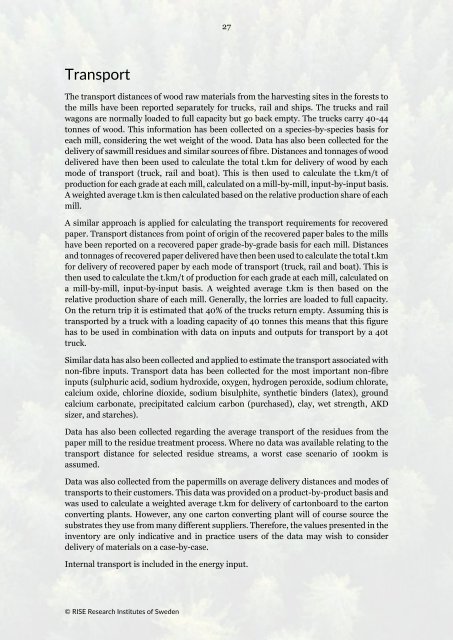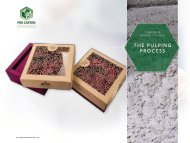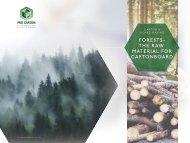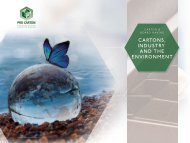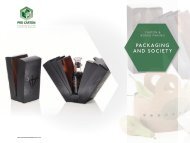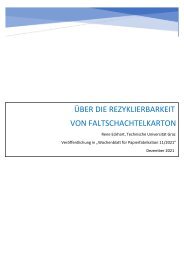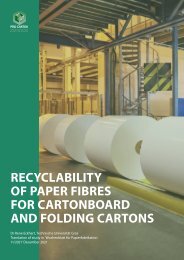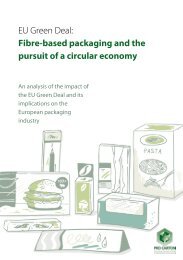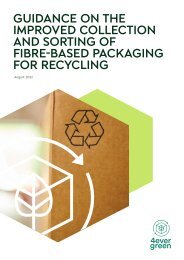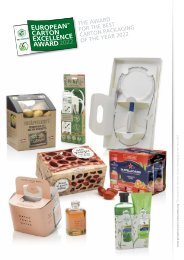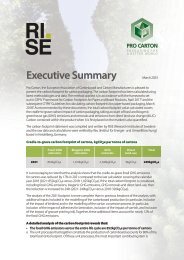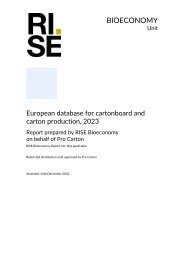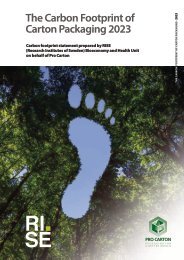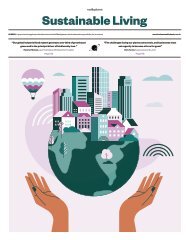European Database for Cartonboard and Carton Production 2023
Create successful ePaper yourself
Turn your PDF publications into a flip-book with our unique Google optimized e-Paper software.
24<br />
Material outputs<br />
The main output from the paper mills is of course cartonboard. This includes about 2 kg<br />
of cores <strong>and</strong> plugs per tonne paper, which are considered <strong>and</strong> weighed as part of the net<br />
saleable product. The carton converting plants produce cartons. The average moisture<br />
content of the saleable product is estimated at 8% <strong>for</strong> both virgin cartonboard <strong>and</strong><br />
recycled cartonboard. The main saleable by-products from the production of virgin<br />
cartonboard production are tall oil, tall soap <strong>and</strong> turpentine. In addition, some process<br />
residues are utilised as raw materials in other industrial processes. To aid LCA<br />
practitioners in deciding what burdens should be considered <strong>for</strong> residues, the end-of-life<br />
management destinations <strong>for</strong> each residue stream are indicated in the inventories.<br />
Residues<br />
All residues are reported as wet weight, separated according to their basic nature.<br />
Residues are only reported where they leave the system boundaries (i.e., where they are<br />
removed from <strong>and</strong> managed away from the site). As the mill is considered as a blackbox,<br />
energy <strong>and</strong> emissions associated with managing residues internally (onsite) are included<br />
within the gate-to-gate inventory data. The treatment option <strong>for</strong> residues was not<br />
reported by all mills, so extrapolation has been necessary from those mills which did<br />
report this in<strong>for</strong>mation.<br />
For the residue stream Rejects from paper <strong>for</strong> recycling, which is mainly rejects from<br />
pulp preparation from recovered paper, it is estimated that about a third is due to<br />
rejected materials that were associated with the previous use of the paper (<strong>for</strong> example,<br />
staples, paper clips, tags, adhesive labels, unrecovered fibres, etc). The remaining two<br />
thirds is material that is not in any way associated with the previous use of the paper (<strong>for</strong><br />
example, <strong>for</strong>eign items such as textiles, plastic packaging, glass, s<strong>and</strong> <strong>and</strong> grit, etc).<br />
Primary fibre sludge <strong>and</strong> biological treatment sludge from wastewater treatment in mills<br />
are mostly recycled in the process <strong>and</strong> do not leave the site. Where they are exported<br />
from the site <strong>for</strong> treatment, they are mostly recycled (e.g. as an input into the production<br />
of construction materials, as an input into corrugated or tissue production, or as animal<br />
bedding), but may also be applied to l<strong>and</strong> as a soil improver (l<strong>and</strong>spreading), composted<br />
or incinerated with energy recovery. No mills reported sending organic sludges to<br />
l<strong>and</strong>fill.<br />
Ashes, green liquor sludge <strong>and</strong> lime mud are commonly reported residues from the<br />
production of primary fibre-based paper. Ashes are predominantly recycled (as an input<br />
into construction materials) but may also be applied to l<strong>and</strong> as a soil improver<br />
(l<strong>and</strong>spreading). Green liquor dregs may also be recycled (as an input into construction<br />
materials), although a proportion of this residue stream is currently disposed of to<br />
ordinary l<strong>and</strong>fill sites. Lime mud is predominantly applied to l<strong>and</strong> as a soil improver<br />
(l<strong>and</strong>spreading).<br />
For carton production the main waste stream is paper <strong>for</strong> recycling, which is recycled<br />
<strong>and</strong> thus should not be called waste but recyclable material.<br />
© RISE Research Institutes of Sweden


